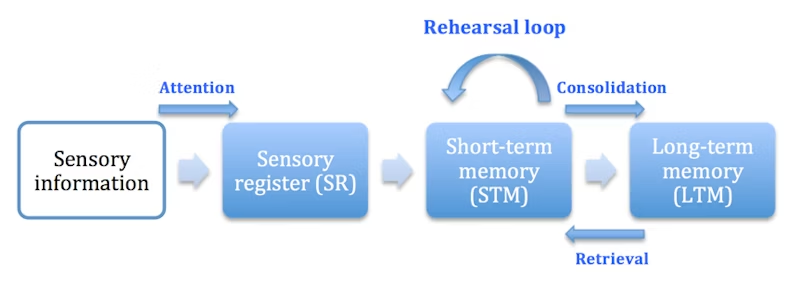2.1 The Multi-Store Model of Memory
1/12
There's no tags or description
Looks like no tags are added yet.
Name | Mastery | Learn | Test | Matching | Spaced |
|---|
No study sessions yet.
13 Terms
What is the multi-store model of memory?
cognitive model of memory
involves the forward flow of information from sensory input, through to the sensory register (SM).
How does information pass through the multi-store model of memory?
Sensory information passes from SR to STM via attention. The information then passes from STM to LTM via rehearsal. Information can be passed back from LTM to STM via retrieval.

What is the SCOUT for MSM?
S: Case study of H.M
C: H.M could improve his procedural memory (Star task) shows MSM is too simple
O: WMM suggests STM is more complex and has two slave systems
U: Can help with revision or retaining information → elaborative rehearsal.
T: Lab experiments can be used, high control, cause and effect, high internal, repeats, though ecological.
What is encoding for both STM and LTM?
How the information is processed from the senses into the memory itself. Either semantic (LTM) or acoustic (STM).
What is the duration of STM?
18-20 seconds
What is the duration of LTM?
A lifetime
What is the capacity of STM?
7+-2
What is the Capacity of LTM?
An unlimited capacity.
What are the three types of Long-term memory?
- Episodic
- Procedural
- Semantic
What is Episodic memory?
Experiences a person has had or events from their life.
e.g. 16th birthday party
What is Procedural memory?
It involves knowing how to do certain actions or skills.
e.g. how to ride a bike
What is Semantic memory?
It involves knowing and recalling facts, concepts and meanings.
e.g. knowing that Paris is the capital of France
What is SCOUT for LTM?
S: Tulving (1989) tracked blood flow to different areas of hi brain whilst performing different types of LTM. Found that each LTM was associated with a different region of the brain.
Case study of H.M
C/O: Cohen and Squire suggested that there are two types of LTM declarative and non-declarative and episodic and semantic are in the same declarative store.
U: Can help target specific memories to help people with mild cognitive impairment.
T: Lack of control and low in reliability, hard to apply findings to wider popu.